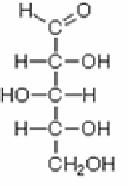Environmental Engineering Reference
In-Depth Information
3.3.7. Furfural
Since there is no synthetic route available for furfural production, this chemical
compound is exclusively produced from lignocellulosic biomass by dehydrating C5 sugars
(mainly xylose) which are present in the hemicellulose fraction (see Figure 10). Furfural
(C
5
H
4
O
2
), together with its derivates, is an important chemical because is a selective solvent
for separating compounds in petroleum refining, gas, oil and diesel fuel. The main furfural
derivate is furfuryl alcohol, a basic component for furan resins, but a wide range of products
can also be produced through different chemical reactions, such as methylfuran (MF, a
pharmaceutical compound), methyltetrahydrofuran (MTHF, a fuel additive), maleic acid
(MA, a commodity chemical) and Nylon 6.6 (a polyamide), among others (Kamm et al.,
2006b; Vazquez et al., 2007).
-3 H
2
O
Furfural
Xylose
Figure 10. Production of xylose from dehydratation of xylose.
3.3.8. Pyrolytic liquid
Pyrolytic liquid is the product of the pyrolysis process applied to biomass feedstocks; in
the case of flash pyrolysis, the yield of pyrolytic oil is about 75%. Pyrolytic liquid (or bio-
oils) is a multi-component mixture of different size molecules derived from depolymerization
and fragmentation of the feedstock. Therefore, the elemental composition of bio-oil and
petroleum derived fuel is different, and they cannot be mixed. Pyrolytic liquid has a water
content of 20-30%, and an oxygen content of 35-40% (but if only lignin is pyrolysed this
value can decrease to 20%); it is highly corrosive and with a lower heating value of 20 MJ/kg
(Bridgwater and Peacocke, 2000; Spilae et al., 1998). The 99.7% (dry weight) of pyrolytic oil,
is composed of acids, alcohols, aldehydes, esters, ketones, sugars, phenols, guaiacols,
syringols, furans, lignin derived phenols and extractible terpene with multi-functional groups.
Many of these substances can be extracted, such as phenols, volatile organic acids,
levoglucosan and others, but the utilization of pyrolytic oil as a fuel for stationary generation
of steam and power remains, to date, the most suitable alternative (Zhang et al., 2007).
3.3.9. Vegetable oil
Vegetable oil can be extracted from nearly any oilseed crop for potential use as biofuels
or as a chemical substrate. They are made of triglycerides which typically consist of glycerin
and saturated and unsaturated fatty acids. Triglycerides have two chemically reactive sites
and thanks to this reactivity, a wide range of products can be produced, such as: biodiesel
(giving glycerin as a co-product), dicarboxylic acid (by bio-oxydation), polyamides and
polyurethanes (i.e. bio-plastics), among others (Hill, 2006).










